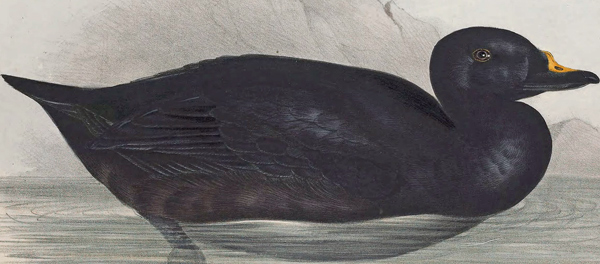
The black scoter (Melanitta nigra) takes its name from the plumage of the male, the only solid black duck in North America. While his outspread flight feathers are silvery in color, no significant contrast is visible on the male black scoter except the large bright orange knob at the base of his bill.
Females, nonbreeding males, and immature ducks are also dark, but more brown in color and less uniform. They display lighter, grayish cheeks and a pale throat. They can also appear grayish below when seen in flight.
One feature that male and female black scoters share in common is their build, which resembles that of a dabbling duck. Compared to other scoters, the black scoter is heavy-bodied with a relatively round head and thin bill.
Best Field Marks

- Silhouette similar to a large dabbling duck.
- Solid black plumage of male.
- Bright orange knob at base of bill in males.
- Pale cheeks and throat on females.
Voice
Black scoters are typically silent, producing only a whistling sound from the wings when in flight. However, they are known to make a cour-loo call, which sounds musical when produced by the male and harsh when produced by the female.
Distribution & Occurrence

The black scoter primarily breeds in Alaska, and also in parts of Canada. It winters along both the Pacific and Atlantic coasts as far south as Texas.
While this is the least likely scoter species to be seen inland, Kansas has witnessed an increasing number of sightings since the 1950s, when many of the big reservoirs were constructed. Most sightings come from Cheyenne Bottoms, but 13 counties from the eastern and central parts of the state have reports.
Most of the black scoters seen in Kansas have been immature ducks passing through during fall migration, generally from late October through late November. However, one sighting occurred on March 18.
Behavior
This duck is known for its direct flight and strong, fast wing beats. A group of black scoters in flight may use either a straight line or a V formation.
The black scoter is a sea duck that dives for its food, typically preferring to feed at a depth of about 25 feet below the surface of the water. It is completely carnivorous, primarily living on mollusks.
Attracting

Backyard birdwatchers are not likely to have an opportunity to attract black scoters.
Hunters find that this species comes very reliably to black scoter decoys.
Similar Species
Coots
A coot has a white bill, unlike the dark bill and yellow knob of a black scoter.
Female Scoters
The male black scoter in breeding plumage is distinctive, being the only entirely black duck around and having a bright orange knob at the base of his bill. Females are harder. The other two scoter species, surf and white-winged, both have light spots on the sides of their head, while the black scoter has a pale cheeks and throat. Furthermore, a cap marks a surf scoter and a white wing patch a white-winged scoter. Unfortunately, in bad lighting, the differences may be subtle enough to be unreliable. Both the surf and white-winged scoter have thicker necks and heavier bills, while the black scoter is built more like a dabbling duck.
Ruddy Duck
A female black scoter could conceivably be mistaken for the ruddy duck in winter plumage. However, note that the ruddy duck is smaller and paler overall, with a unique stiff tail. Also, the ruddy duck retains his white cheek patch in nonbreeding plumage, presenting strong contrast. The pale cheek color of the female black scoter is more diffuse by comparison and extends down the front of the throat.
Helpful Resource
Black Scoter
Photos, audio, and more information from Cornell’s All About Birds site.
Complete Series

